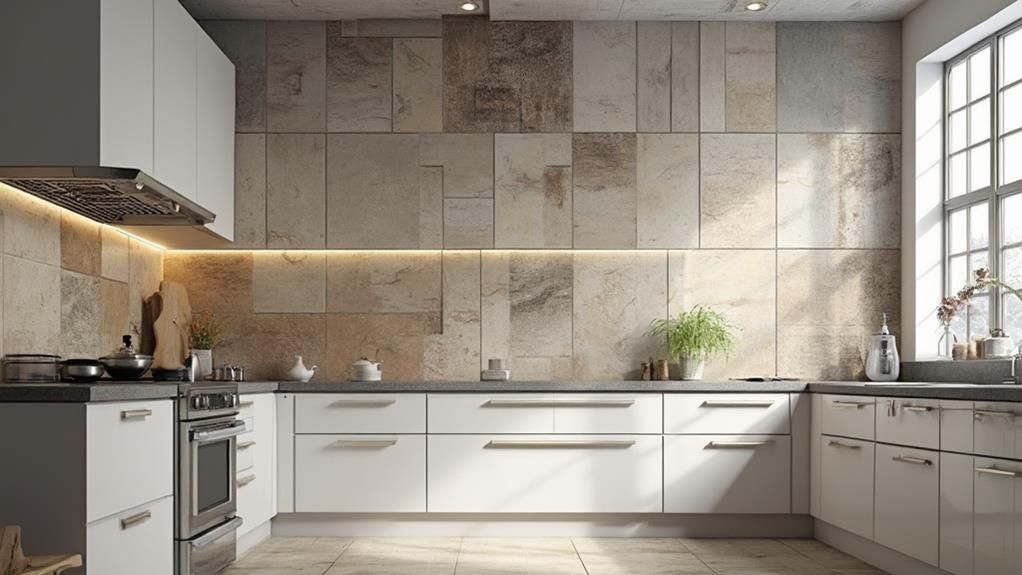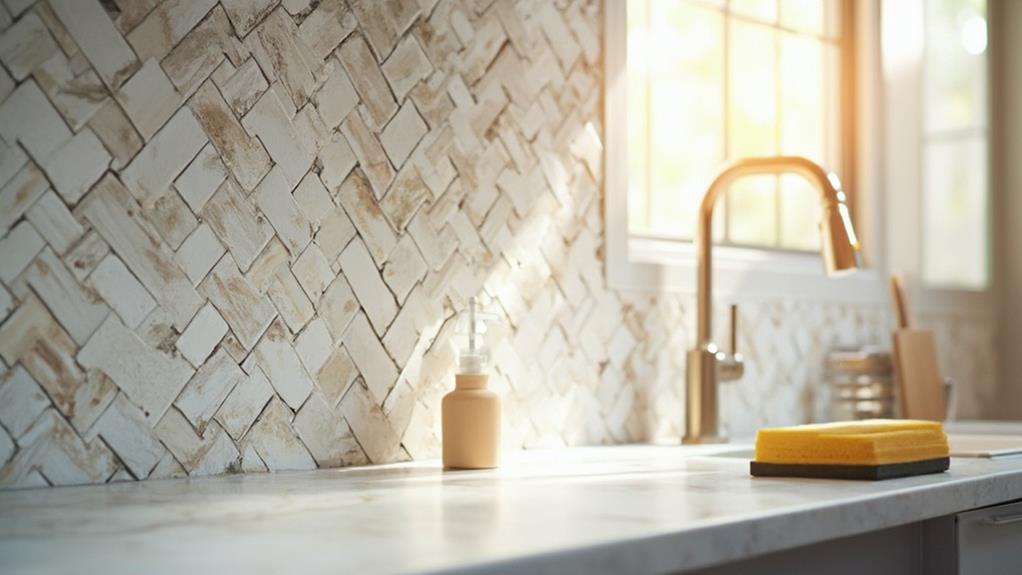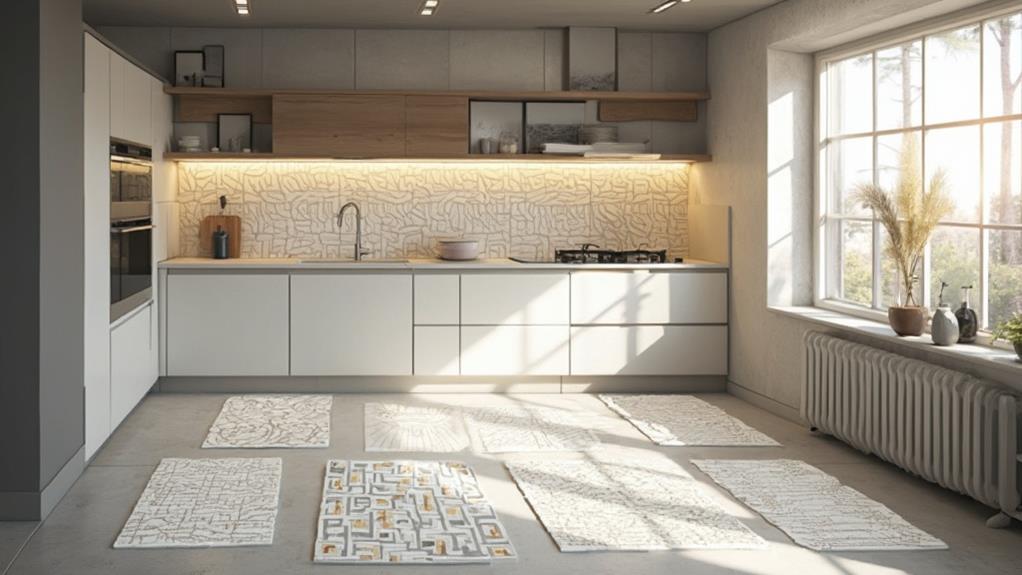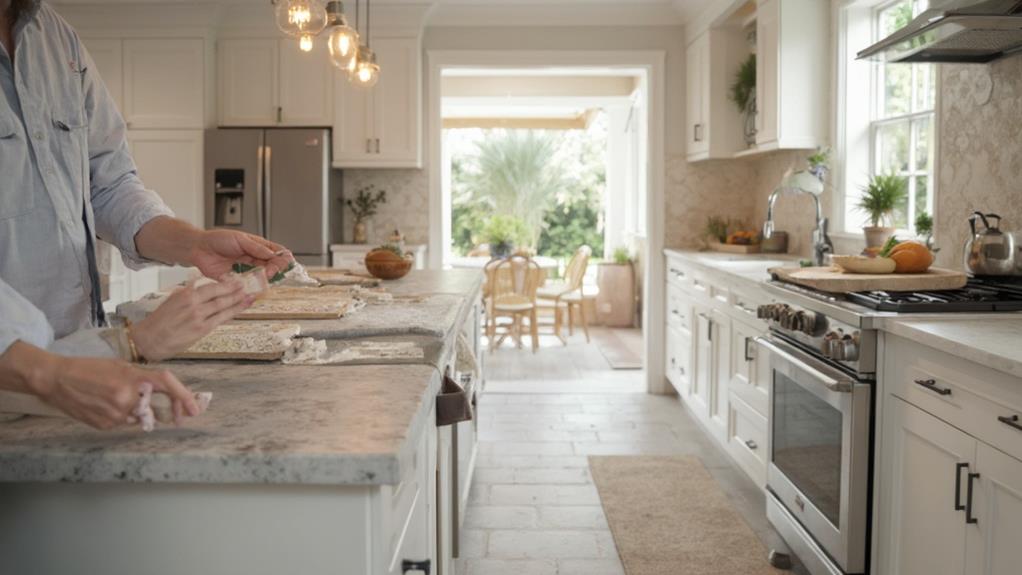To choose the right tile pattern for your kitchen, start by assessing your existing style and desired atmosphere. Consider popular options like subway, herringbone, or chevron patterns, and factor in practicality and maintenance needs. Select colors and materials that complement your kitchen's palette and suit your budget. Durability is key, so opt for ceramic or porcelain tiles in high-traffic areas. Visualize patterns using samples, online tools, or mock-ups to see how they'll look in your space. Don't forget to consider lighting effects and how the pattern will impact the overall feel of your kitchen. By following these tips, you'll be on your way to creating a stunning backsplash.
Assessing Your Kitchen's Style

When choosing tile patterns for your kitchen, it's crucial to first assess your kitchen's overall style. Look at the existing elements, such as cabinetry, countertops, and appliances. Are they modern and sleek, traditional and ornate, or somewhere in between? Your tile pattern should complement these features, not clash with them.
Consider the color palette of your kitchen. Are you working with warm or cool tones? Neutral or bold hues? The tile pattern you choose should harmonize with these colors, either by matching or providing a pleasing contrast.
Think about the atmosphere you want to create. Do you prefer a calm, minimalist space or a lively, eclectic environment? Certain tile patterns can contribute to these moods. For example, simple grid patterns often suit modern kitchens, while intricate mosaics might work better in more traditional settings.
Don't forget to factor in the size of your kitchen. Large-scale patterns can overwhelm small spaces, while tiny patterns might get lost in larger areas. Also, consider the amount of natural light your kitchen receives, as this can affect how tile patterns appear throughout the day.
Popular Tile Pattern Options
Now that you've assessed your kitchen's style, let's explore some popular tile pattern options. The classic subway tile pattern remains a timeless choice, featuring rectangular tiles arranged in a horizontal, staggered layout. It's versatile and suits both modern and traditional kitchens.
For a more dynamic look, consider the herringbone pattern, which creates a visually striking zigzag effect using rectangular tiles.
If you're after a bold statement, try the chevron pattern. Similar to herringbone but with angled cuts, it adds a sense of movement and sophistication. The basketweave pattern, consisting of alternating vertical and horizontal rectangular tiles, offers a textured, woven appearance that works well in rustic or farmhouse-style kitchens.
For a contemporary feel, opt for a vertical stack bond pattern, where tiles are aligned in straight columns. This creates clean lines and a sleek aesthetic. Alternatively, the penny round pattern uses small circular tiles to create a charming, retro vibe. Finally, consider the Moroccan fish scale pattern for an exotic touch, featuring overlapping curved tiles that resemble fish scales.
Considering Practicality and Maintenance

Beyond the aesthetics of tile patterns, you'll need to consider practicality and maintenance in your kitchen. Opt for tiles that can withstand heavy foot traffic, spills, and frequent cleaning. Porcelain and ceramic tiles are durable choices that resist stains and moisture.
Consider the size of the tiles and grout lines. Larger tiles with fewer grout lines are easier to clean and maintain, while smaller tiles with more grout can be trickier to keep pristine. If you choose smaller tiles, select a grout that's stain-resistant and easy to clean.
Think about the texture of your tiles. Smooth surfaces are easier to wipe down, but they can be slippery when wet. Textured tiles offer better traction but may require more effort to clean thoroughly.
The color of your tiles can also impact maintenance. Lighter colors show dirt and stains more easily, while darker shades may hide imperfections better but can make your kitchen feel smaller.
Lastly, consider the pattern's complexity. Intricate designs might look stunning, but they can be challenging to replace if a tile becomes damaged. Simpler patterns allow for easier repairs and replacements in the future.
Color and Material Selection
After considering practicality, it's time to dive into the exciting world of color and material selection for your kitchen tiles. Your choice of color and material will significantly impact the overall look and feel of your kitchen.
Start by assessing your kitchen's color scheme and style. For a cohesive look, choose tiles that complement your cabinets, countertops, and appliances. If you want to make a statement, opt for contrasting colors or bold patterns. Consider the size of your kitchen too; lighter colors can make small spaces feel larger, while darker hues add depth to spacious areas.
When it comes to materials, you've got plenty of options. Ceramic tiles are versatile, affordable, and easy to maintain. Porcelain tiles offer durability and water resistance, making them ideal for high-traffic areas. Natural stone tiles like marble or slate provide a luxurious look but require more maintenance. Glass tiles can add a sleek, modern touch and reflect light beautifully.
Don't forget to factor in your lifestyle and budget. Some materials are more expensive and require special care, while others are more budget-friendly and low-maintenance. Choose a combination that suits your needs and aesthetic preferences.
Visualizing Patterns in Your Space

A picture is worth a thousand words when it comes to visualizing tile patterns in your kitchen. To get a clear idea of how different patterns will look in your space, use a variety of tools and techniques. Start by requesting samples from tile suppliers and laying them out on your kitchen floor or countertop. This hands-on approach allows you to see how the tiles interact with your existing decor and lighting.
For a more comprehensive view, try using online design tools or mobile apps that let you upload photos of your kitchen and superimpose various tile patterns. These digital solutions offer the advantage of experimenting with multiple options quickly and easily. Don't forget to consider how the pattern will look from different angles and distances in your kitchen.
If you're still unsure, consider creating a small mock-up area using inexpensive materials like construction paper or painter's tape to outline the proposed pattern on your surfaces. This method helps you visualize the scale and flow of the pattern in your actual space. Remember to view your mock-up at different times of day to see how changing light affects the pattern's appearance.
Working With a Professional
When it comes to choosing tile patterns for your kitchen, teaming up with a professional can make all the difference. A skilled interior designer or tile specialist brings expertise and experience to the table, helping you navigate the myriad of options available. They'll consider your kitchen's layout, lighting, and overall style to suggest patterns that complement your space.
These experts can introduce you to innovative designs you mightn't have considered, such as herringbone or Moroccan-inspired patterns. They'll also guide you through practical considerations like maintenance requirements and durability. A professional can create detailed mockups or 3D renderings, giving you a clear vision of how different patterns will look in your kitchen.
Working with a pro can save you time and prevent costly mistakes. They'll ensure proper measurements, recommend quality materials, and coordinate with installers to achieve the best results. Additionally, they often have access to a wider range of tile options, including custom or specialty tiles that aren't readily available to the public. By leveraging their industry connections, you might even score better prices on materials and installation.
Conclusion
You've meticulously planned every aspect of your tile pattern, considered countless options, and agonized over every detail. Ironically, after all that effort, you'll probably spend more time admiring your neighbor's kitchen than your own. But don't worry, your guests will appreciate your hard work—for about five seconds before they dive into the food you've prepared. In the end, remember: it's just tile. Your cooking skills matter more than your backsplash choice.

